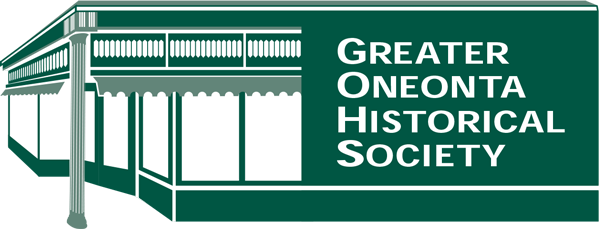Historic Main Street
Welcome to this self-guided tour of Main Street Oneonta, part of the Downtown Oneonta Historic District on the New York State and National Registers of Historic Places. We’re proud of our historic downtown, and pleased to share it with you.

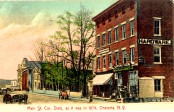 This is the oldest brick building on Main Street, built in 1866, the year after the railroad came to Oneonta. Through the years the first floor held a hardware store, a restaurant, a dress shop, and a jewelry store. It has been the home of the Greater Oneonta Historical Society since 2005. Up Dietz Street you will see the Destination Oneonta Welcome Center, the site of the Post Office from about 1890 to 1915.
This is the oldest brick building on Main Street, built in 1866, the year after the railroad came to Oneonta. Through the years the first floor held a hardware store, a restaurant, a dress shop, and a jewelry store. It has been the home of the Greater Oneonta Historical Society since 2005. Up Dietz Street you will see the Destination Oneonta Welcome Center, the site of the Post Office from about 1890 to 1915.

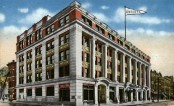 The original hotel on this site was the Central Hotel, built in 1873. It burned in 1910 and was soon replaced by the Oneonta Hotel. Note the lion heads and the Ionic columns on the Beaux Arts building. Broad Street once ran from the hotels on this site to the Delaware & Hudson railroad depot on Market Street.
The original hotel on this site was the Central Hotel, built in 1873. It burned in 1910 and was soon replaced by the Oneonta Hotel. Note the lion heads and the Ionic columns on the Beaux Arts building. Broad Street once ran from the hotels on this site to the Delaware & Hudson railroad depot on Market Street.

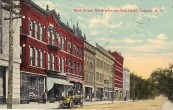
 Woolworth’s and Newberry’s were among several national chains on Main Street in the middle of the 20th century. Others included A & P, Grand Union, WT Grant, SS Kresge, JC Penney, and Sears Roebuck.
Woolworth’s and Newberry’s were among several national chains on Main Street in the middle of the 20th century. Others included A & P, Grand Union, WT Grant, SS Kresge, JC Penney, and Sears Roebuck.
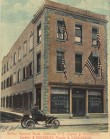
 Wilber Bank moved to Oneonta in 1873 and was chartered in 1874. The bank at this site was built in four phases, beginning in 1907 with the wing at the west end. Wilber National Bank merged with Community Bank in 2011.
Wilber Bank moved to Oneonta in 1873 and was chartered in 1874. The bank at this site was built in four phases, beginning in 1907 with the wing at the west end. Wilber National Bank merged with Community Bank in 2011.

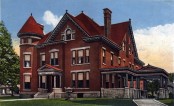 Built in 1867 by David Yager in the Italianate style, it was remodeled in 1891 in the Queen Anne style by George Fairchild. Fairchild was a US congressman and the first chairman of the board of IBM. Oneonta Masonic Lodge No. 466 has occupied the building since 1929.
Built in 1867 by David Yager in the Italianate style, it was remodeled in 1891 in the Queen Anne style by George Fairchild. Fairchild was a US congressman and the first chairman of the board of IBM. Oneonta Masonic Lodge No. 466 has occupied the building since 1929.

 Behind the First Presbyterian Church is Oneonta’s most historic cemetery. In 1805 Frederick Brown deeded the land for the church, parsonage, and cemetery. It was called Riverside because it was by the side of the Susquehanna River until the river was diverted in 1815. In 1860 the cemetery became independent of the church.
Behind the First Presbyterian Church is Oneonta’s most historic cemetery. In 1805 Frederick Brown deeded the land for the church, parsonage, and cemetery. It was called Riverside because it was by the side of the Susquehanna River until the river was diverted in 1815. In 1860 the cemetery became independent of the church.

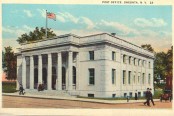 Oneonta’s City Hall was added to the Register of Historic Places as the Old Post Office. When the new post office was completed in 1967, the Old Post Office was slated for demolition, but community opposition saved it from urban renewal and led to its adaptive reuse as Oneonta’s City Hall.
Oneonta’s City Hall was added to the Register of Historic Places as the Old Post Office. When the new post office was completed in 1967, the Old Post Office was slated for demolition, but community opposition saved it from urban renewal and led to its adaptive reuse as Oneonta’s City Hall.
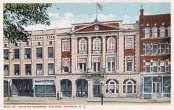
 Built in 1906, Oneonta’s first city hall is a mix of the Neo-Classical Revival and Beaux Arts styles. It served as seat of municipal government and the police and fire departments until 1980 when city offices moved to the Old Post Office.
Built in 1906, Oneonta’s first city hall is a mix of the Neo-Classical Revival and Beaux Arts styles. It served as seat of municipal government and the police and fire departments until 1980 when city offices moved to the Old Post Office.

 The parking lot here was the site of the Westcott Block, a four-story building with a clock tower. Hops merchants Luzerne and Munro Westcott had the building constructed in 1886 for their offices. The building was razed in 1968 and the clock tower stored. The clock is now on display in the Walkway at 190 Main Street.
The parking lot here was the site of the Westcott Block, a four-story building with a clock tower. Hops merchants Luzerne and Munro Westcott had the building constructed in 1886 for their offices. The building was razed in 1968 and the clock tower stored. The clock is now on display in the Walkway at 190 Main Street.

 Broad Street with its hotels, bars, restaurants, and the city’s first YMCA had connected the railroad station to Main Street for more than 100 years. It disappeared without a trace between 1974 and 1976, a victim of urban renewal. The large, empty lot was not filled until more than a quarter century later when Muller Plaza was dedicated and the Clarion Hotel built.
Broad Street with its hotels, bars, restaurants, and the city’s first YMCA had connected the railroad station to Main Street for more than 100 years. It disappeared without a trace between 1974 and 1976, a victim of urban renewal. The large, empty lot was not filled until more than a quarter century later when Muller Plaza was dedicated and the Clarion Hotel built.

 Eliakim Ford had a stone store on the site in 1840. After a disastrous Main Street fire in 1881, his grandson Newton Ford and others built the Ford Block. The block was slated for demolition during urban renewal, with plans to use the space for a shopping center, but funding ran out and the building was saved.
Eliakim Ford had a stone store on the site in 1840. After a disastrous Main Street fire in 1881, his grandson Newton Ford and others built the Ford Block. The block was slated for demolition during urban renewal, with plans to use the space for a shopping center, but funding ran out and the building was saved.
 The string of light-colored brick buildings was once the site of Wooden Row, among the last wooden buildings along Main Street. Periodic fires downtown precipitated the move from wood to brick building materials. The worst of these fires destroyed Wooden Row on December 27, 1908.
The string of light-colored brick buildings was once the site of Wooden Row, among the last wooden buildings along Main Street. Periodic fires downtown precipitated the move from wood to brick building materials. The worst of these fires destroyed Wooden Row on December 27, 1908.


 At the end of the 19th century, residences and businesses lined this section of Main Street. This 1903 map mistakenly shows Market St. as Markle St. In 1921 part of this area became Brown Park, donated to the city by Walter Brown, who lived across street at 97 Main. Much of the land became a parking lot in the 1950s, then the Clinton Plaza development in the 1970s. The only remnant of the park is the spit of land around monument to the 1779 Clinton-Sullivan expedition.
At the end of the 19th century, residences and businesses lined this section of Main Street. This 1903 map mistakenly shows Market St. as Markle St. In 1921 part of this area became Brown Park, donated to the city by Walter Brown, who lived across street at 97 Main. Much of the land became a parking lot in the 1950s, then the Clinton Plaza development in the 1970s. The only remnant of the park is the spit of land around monument to the 1779 Clinton-Sullivan expedition.
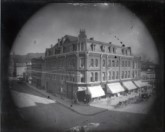
 Peter Dinniny had a general store at this corner in 1790, the first in what would become the commercial district. In 1872 the Stanton Opera House was built on the same site.
Peter Dinniny had a general store at this corner in 1790, the first in what would become the commercial district. In 1872 the Stanton Opera House was built on the same site.

 This is the oldest building on Main Street, originally stone with a wood front. After a fire in 1890 a third floor was added along with the metal facade. For 74 years it was the City Drug Store. The Novelty Lounge has been at this site since 1970. The late 1960s’ photo shows Frew’s Bakery at 149 Main.
This is the oldest building on Main Street, originally stone with a wood front. After a fire in 1890 a third floor was added along with the metal facade. For 74 years it was the City Drug Store. The Novelty Lounge has been at this site since 1970. The late 1960s’ photo shows Frew’s Bakery at 149 Main.

 Stevens was a Main Street institution for 130 years. Founded by T. Waldo Stevens in 1882, it changed with the times, from repairing carriages, to selling hardware, to being a fish and game store. John Stevens (1918-2012), grandson of the founder, ran the family business until 2012. Note the building’s ornate facade.
Stevens was a Main Street institution for 130 years. Founded by T. Waldo Stevens in 1882, it changed with the times, from repairing carriages, to selling hardware, to being a fish and game store. John Stevens (1918-2012), grandson of the founder, ran the family business until 2012. Note the building’s ornate facade.
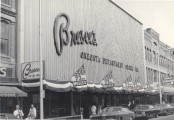
 Bresee’s department store was a mecca for area shoppers for a century. A 1949 article in Collier’s Magazine compared the store owned by the Bresee family to Macy’s and Gimbels. Bresee’s closed in 2005. Only one third of the department store complex remains, with retail on the first floor and apartment living on the upper floors.
Bresee’s department store was a mecca for area shoppers for a century. A 1949 article in Collier’s Magazine compared the store owned by the Bresee family to Macy’s and Gimbels. Bresee’s closed in 2005. Only one third of the department store complex remains, with retail on the first floor and apartment living on the upper floors.
